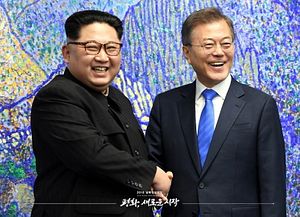The third inter-Korea summit is in the books. South Korean President Moon Jae-in and North Korean leader Kim Jong-un met in Panmunjom, the “peace village” in the Demilitarized Zone, on April 27, after weeks of anticipation.
Moon and Kim shook hands at the military demarcation line (MDL) dividing their countries at around 9:30 am, local time, then Kim stepped over the line to join Moon on South Korean soil – a first for a North Korean leader since the two countries split. Before the two headed off for the formal welcoming ceremony, however, Kim – in a reportedly unscripted exchange – invited Moon to cross the MDL and stand with him back on North Korea’s side. The two men, holding hands, stepped again over the de facto border and stood briefly on the northern side, before returning again to the south – a clear demonstration of just how artificial the boundary is.
As Kim put it in comments to Moon later, “The MDL isn’t even that high, and I believe it will eventually disappear when many people step over to cross it.”
Moon and Kim each brought a long list of officials with them for the summit, including top defense, foreign policy, and national security ministers. The North Korean delegation included Kim’s sister, Kim Yo-jong, as well as Nominal President Kim Yong-nam, Vice Chair of the Party Central Committee Kim Yong-chol, Chief of the Korean People’s Army (KPA) General Staff Ri Myong-su, Minister of the People’s Armed Forces Pak Yong Sik, Foreign Minister Ri Yong Ho, and Chairman of the Committee for the Peaceful Reunification of the Country Ri Son Gwon. South Korea was represented by Presidential Chief of Staff Im Jong-seok, Unification Minister Cho Myoung-gyon, Foreign Minister Kang Kyung-wha, Defense Minister Song Young-moo, Chief of National Intelligence Service Suh Hoon, Director of National Security Chung Eui-yong, and Chairman of the ROK Joint Chiefs of Staff Gen. Jeong Kyeongdoo, among others. Moon and Kim’s wives also joined their husbands for a banquet after the official summit.
The summit culminated in a joint statement, the “Panmunjeom Declaration for Peace, Prosperity and Unification of the Korean Peninsula,” which declared that “a new era of peace has begun.” Most notably, the statement “confirmed the common goal of realizing, through complete denuclearization, a nuclear-free Korean Peninsula.”
As Ankit Panda has pointed out, achieving this goal would, in practice, mean providing security guarantees to North Korea, with South Korea also required to make sacrifices to achieve “complete denuclearization. It’s not clear at this point what that would entail – some possible demands from Kim might include an end to the U.S. “nuclear umbrella” protecting South Korea, for example, or the removal of U.S. troops from the Peninsula. The declaration also pledged more generally that both sides would “carry out disarmament in a phased manner.” The hard part of defining what “disarmament” and “complete denuclearization” look like will be the next major task.
Moon and Kim also agreed to push forward with a formal peace agreement, to replace the armistice signed in 1953 that halted the Korean War. The declaration noted that “Bringing an end to the current unnatural state of armistice and establishing a robust peace regime on the Korean Peninsula is a historical mission that must not be delayed any further.” The two Koreas will thus discuss a peace treaty and “a permanent and solid peace regime” in either trilateral talks (involving North and South Korea alongside the United States) or quadrilateral talks (bringing China in as well). Notably, either configuration would leave out two members of the previous Six Party Talks: Japan and Russia.
More immediately, the two Koreas agreed to cease “all hostile acts” along the DMZ by May 1. That will include an end to South Korea’s loudspeaker broadcasts, a long-standing irritant to Pyongyang.
Moving forward, both sides agreed to keep high-level communication flowing. They will establish a joint liaison office in Kaesong, in North Korea close to the border (famous for hosting a now-shuttered joint industrial complex). The two sides also plan to hold regular Defense Ministers Meeting “in order to immediately discuss and solve military issues.”
On the people-to-people level, cultural exchanges will continue and there will be a new round of family reunions for those separated from loved ones by the Korean War. Seoul and Pyongyang will also return to implementing previously agreed upon projects, including connecting North and South Korean railways to form a transportation corridor along the eastern side of the peninsula. In a rare moment of self-deprecation, Kim admitted to Moon that North Korean transportation systems might not measure up to South Korean standards; in response, Moon emphasized the importance of a connected railway system.
Moon is now officially set to visit North Korea this fall, and he has high hopes that won’t be the last exchange. “I hope today’s meeting in Panmunjeom can be followed by future meetings in Pyeongyang, Seoul, on Jeju Island and at Baekdusan Mountain,” Moon said. Kim also indicated he would be “willing” to visit the Blue House in Seoul if invited, which would be a first for a North Korean leader. Moon, however, will be following in the footsteps of two previous South Korean presidents when he travels to Pyongyang.
With the successful conclusion of the inter-Korea summit, all eyes are turning to the White House for its response. A historic summit meeting between Kim and U.S. President Donald Trump has been floated for May or June, although the details – including the location of the meeting – have yet to be finalized. But while a Trump-Kim summit was in the minds of observers, Friday was all about the two Koreas.
As Moon put it, “Chairman Kim and I are the main characters today.”

































